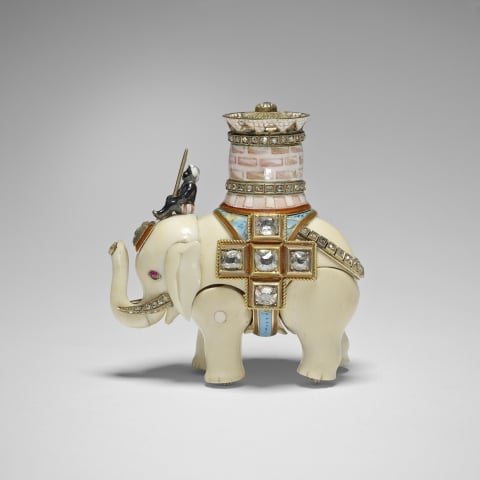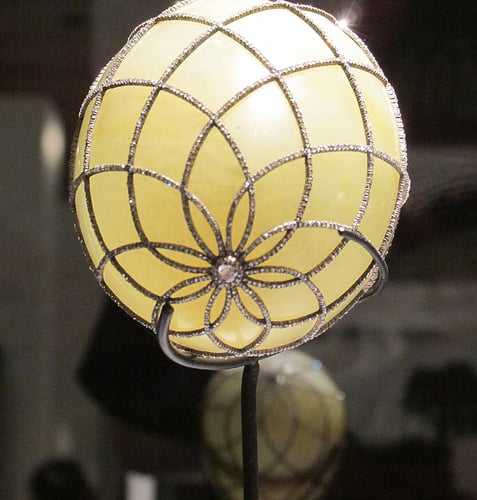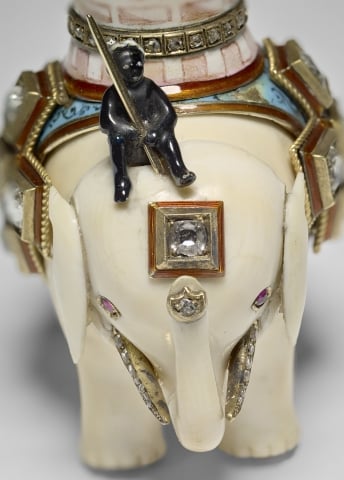Art World
Secret Object Hidden in Fabergé Egg Discovered in British Royal Collection
The bejeweled elephant has belonged to the royal family since 1929.
The bejeweled elephant has belonged to the royal family since 1929.
A long-lost Fabergé treasure has been discovered in the British royal family’s art collection: An automaton elephant embellished in diamonds and rubies originally hidden as a “surprise” inside the Diamond Trellis Egg commissioned by czar Alexander III in 1892.
The find was announced this week by Royal Collection Trust senior curator Caroline de Guitaut at a conference at the Fabergé Museum in St. Petersburg. The Trust (currently exhibiting photos of Queen Elizabeth II) boasts an impressive collection of Russian lapidary art, but no one suspected that the tiny elephant, acquired by King George V in 1935, had an imperial pedigree.

Peter Carl Fabergé, the elephant automaton from the Diamond Trellis egg (1892).
Photo: Royal Collection Trust/© Her Majesty Queen Elizabeth II 2015.
The famed imperial eggs, created for the Russian royal family between 1885 and 1917, were looted during the Russian Revolution in 1917. This past year, an 1887 imperial egg worth an estimated $33 million was discovered in an antique store in the Midwest. Fabergé remains an icon even to the present day, with a larger-than-life egg hunt held in New York this past spring, and high-profile thefts of the jewel-encrusted treasures.
The Diamond Trellis Egg, an Easter gift for Empress Maria Feodorovna created by August Holmstrom, is made of a semi-translucent pale green stone, lined with rose-cut diamonds. It eventually made its way to the US, and now belongs to the McFerrin family. At some point during its travels, it was separated from its sculptural base, which featured three putti and remains missing, and its tiny surprise.

Peter Carl Fabergé, the Diamond Trellis egg (1892).
Photo: ShannonCe via Flickr.
Fabergé’s general account ledgers described the elusive object as an “ivory figure of an elephant, clockwork, with a small gold tower, partly enamelled and decorated with rose-cut diamonds,” and “a black mahout… seated on its head.”
When de Guitaut was compiling a new catalogue of the trust collection, she realized the tiny figure was quite similar to the missing imperial treasure. “It suddenly struck me: it might be the very elephant!” she said during her a presentation on her discovery.

Peter Carl Fabergé, the elephant automaton from the Diamond Trellis egg (1892).
Photo: Royal Collection Trust/© Her Majesty Queen Elizabeth II 2015.
A group of restorers led by the Trust’s clockmaker carefully dissembled the elephant figurine. “We removed the upper part of the tower, and my heart almost stopped beating: There was a Fabergé stamp on it!” exclaimed de Guitaut, having found her proof.
Despite its age, the automaton, now restored, still works perfectly, to de Guitaut’s delight. “Words cannot describe our emotions, when the winding key fit ideally to the mechanism, and the elephant started walking, moved its legs, nodded, for the first time in 80 years!”
See a video of the “surprise” in action:
The Diamond Trellis Egg is on view in “Fabergé: From a Snowflake to an Iceberg” at the Houston Museum of Natural Science from September 19, 2014–December 31, 2015.